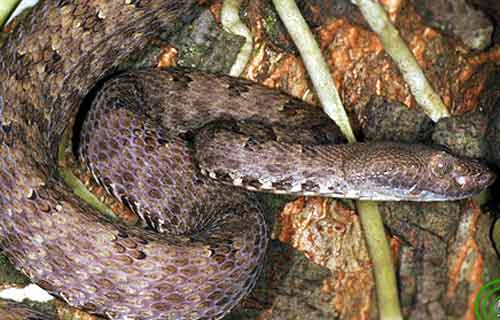New “Rattlesnake” Discovered
Posted by: Loren Coleman on August 20th, 2009
Russian and Vietnamese scientists have announced their discovery of a new species of “rattlesnake” (as it is called in the Vietnamese press release, but, no doubt, a “viper”), which belongs to the Protobothrops family, in the Trung Khanh Nature Reserve in the northwestern province of Cao Bang, the Vietnam news agency reported Thursday, August 20, 2009.
Nguyen Thien Tao, who is in charge of amphibians and reptiles at the Vietnam Nature Museum, said this is the fourth species of “rattlesnake” of the Protobothrops family identified in Vietnam.
The three others are Protobothrops cornutus, P.jerdonii and P. mucrosquamatus.
The new species of “rattlesnake” is named Protobothrops trungkhanhensis Orlov, Ryabov, an endemic species found in only the Trung Khanh Nature Reserve in Cao Bang, Vietnam.
The snake is only 733mm in length, quite small compared to other Protobothrops species, with a small triangle-shaped head and small scales.
The discovery was published in a Russian scientific magazine named Reptile and Amphibians in January 2009.
About Loren Coleman
Loren Coleman is one of the world’s leading cryptozoologists, some say “the” leading living cryptozoologist. Certainly, he is acknowledged as the current living American researcher and writer who has most popularized cryptozoology in the late 20th and early 21st centuries.
Starting his fieldwork and investigations in 1960, after traveling and trekking extensively in pursuit of cryptozoological mysteries, Coleman began writing to share his experiences in 1969. An honorary member of Ivan T. Sanderson’s Society for the Investigation of the Unexplained in the 1970s, Coleman has been bestowed with similar honorary memberships of the North Idaho College Cryptozoology Club in 1983, and in subsequent years, that of the British Columbia Scientific Cryptozoology Club, CryptoSafari International, and other international organizations. He was also a Life Member and Benefactor of the International Society of Cryptozoology (now-defunct).
Loren Coleman’s daily blog, as a member of the Cryptomundo Team, served as an ongoing avenue of communication for the ever-growing body of cryptozoo news from 2005 through 2013. He returned as an infrequent contributor beginning Halloween week of 2015.
Coleman is the founder in 2003, and current director of the International Cryptozoology Museum in Portland, Maine.











I’m pretty sure rattlesnakes are only known from the new world. Maybe this was a mistranslation of “viper” or something like that.
Regardless of whether it is a true “rattlesnake” it is a marvelous find. We always enjoy hearing about new species being found. Good story.
When I lived just accross (300km) the border in Guangxi Zhuang Autonomous Region, China, the locals in the remote countryside mentioned a rattlesnake, though I was never able to find any evidence to support it.
When my wife’s grandmother was young, tigers would still come down from the mountains every several days to eat people and some jungle still remains today, so who knows?
Rattlesnakes are a subfamily of venomous snakes known commonly as pit vipers. It seems most people living in urban areas think the world is all paved over and built up but if you look at satellite pictures we haven’t really done that much. The world still has many secrets to share and I would consider this the age of cryptids! Great find there seem to be many undiscovered snakes in Asia.
All rattlesnakes are New World animals. There are many other kinds of pit vipers, however, in other parts of the world. I’d guess that the reference to this snake as “rattlesnake” is due to mistranslation and it should read “new pit viper discovered”.
Interestingly, some other pit vipers, although they don’t possess rattles, use a rattlesnake-like behavior: they vibrate the tips of their tails. I have witnessed this behavior in copperheads and I’ve read of it in other species.
The two times that I have seen copperheads do this, they vibrated their tails and sounded remarkably like rattlesnakes because the tail tips rattled the dry leaves in which the snake was hidden. In fact, the sound probably prevented me being bitten one time, because I did not see the snake at my feet until I heard the leaves rattle.
I think that this was probably something that also occurred during rattlesnake evolution, and, the behavior being advantageous, it gradually led to snakes developing actual rattles.
Just because something is described in literature as not occuring doesn’t mean that it is so… although nothing in the photo reveals what North & South Americans would say is descriptive of a “rattle” sanake.
Case in point – an acquaintance of mine while working as a sketchy quasi-legal commercial Floridian snake hunter decades ago brought in hundreds of Rattlers (among other types of snakes) to the “Herp station”. Among the numerous Canebrakes (sorta Southern version of the Timber Rattler) he brought in, he brought in one a measured ten feet in length. While the Herp station was rather surprised (Literature say 6 foot max.), they informed him that years prior they would on occasion bring in twelve footers.
But as it was primarily mass “production line” hunting for hides, with a small minority for venom, pet sales etc., it went scientifically unreported. These were NOT Eastern Diamondbacks mind you (which Literature claims as eight foot plus max.) but the “supposedly smaller” Canebrakes.